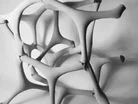Fabric-cast concrete to support future construction methods

The use of concrete within building has been utilised for over 10,000 years and has increasingly become one of the most applied materials within construction. Once cement is dried, concrete provides solid, permanent structures which are durable, weather resistant and reliable.
Whilst studying at UCLA Suprastudio in California, Designers Joseph Sarafian and Ron Culver were asked, “how can motion be integrated into the traditionally stagnant casting process?" by renowned architect Julia Koerner.
Eager to create a method in which concrete could be used to create innovative and flexible designs, the duo began a project as an independent study which would see them robotically manipulate fabric into various shapes. These early experiments were encouraged with the support of Peter Vikar, Shobitha Jacob, Oscar Li and Qi Zhang.
The duo’s aim to create a new method in providing flexibility within a material known for its rigidity, in order to incorporate larger architectural forms would therefore enable architects and designers to build a variety of structures and provide increased freedom.
Through the use of parametric design, which Sarafian explains is “both a movement and a methodology for designing intelligent controls for manipulating and deriving new geometry in 3D software”, sewn lycra sleeves are attached to “6-Axis Kuka robots and stretched into position. Concrete with a fiber admixture is then poured into the sleeves and hardens. The fabric is stripped away with minimal waste, the robots re-position themselves and a new piece is cast”, providing unique fabric forms or shapes.
Read the rest of this article in the December issue of Construction Global
Follow @ConstructionGL



